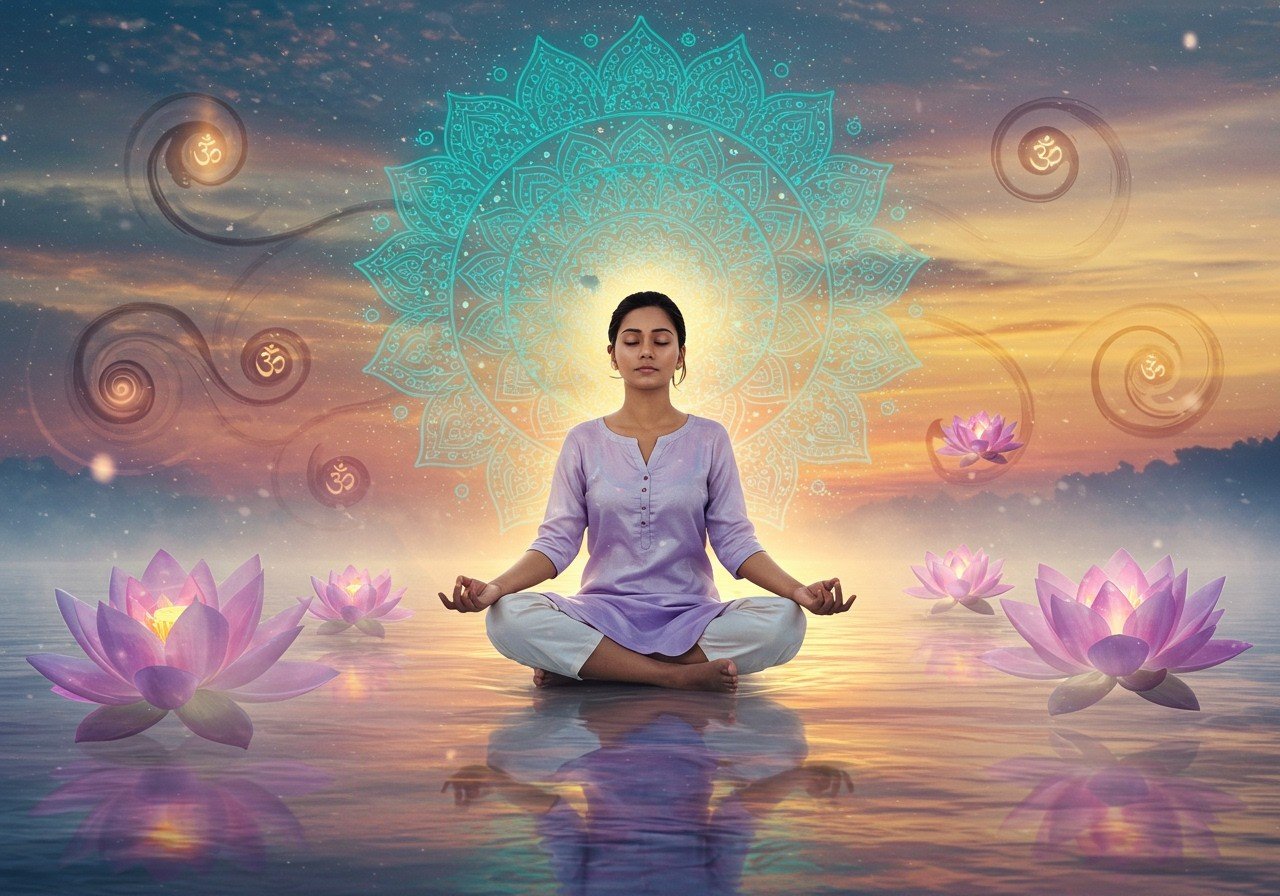
Hindu meditation, a practice rooted in ancient Vedic traditions, offers a pathway to inner peace, mental clarity, and spiritual growth. Drawing from texts like the Vedas and Upanishads, these techniques have been refined over millennia, offering profound benefits for practitioners of all levels. This guide explores the fundamentals of Hindu meditation, providing practical steps and insights for incorporating this transformative practice into your daily life.
Understanding the Core Principles
Several core principles underpin the practice of Hindu meditation. Dharana, the practice of concentration, forms the foundation for developing mindfulness and focus. Pranayama, or breath control techniques, plays a crucial role in preparing the mind for meditation by inducing relaxation and a sense of calm. The repetition of sacred sounds, or mantras, like “Om,” further enhances focus and elevates spiritual awareness. The concept of chakras, energy centers within the body, is also significant, as balancing these centers is believed to promote overall well-being. Finally, creating a sacred space, perhaps adorned with incense, candles, and spiritual symbols, can significantly enhance the meditation experience. While early morning is often considered the ideal time for meditation, maintaining a consistent practice, regardless of the time of day, is key to reaping the benefits.
How to Meditate: A Step-by-Step Guide
Hindu meditation encompasses a variety of techniques, each with its own unique approach. The following steps offer a practical guide to beginning your meditative journey:
Basic Practices:
- Breath Awareness: Establish a comfortable seated position, ensuring your spine remains straight but not rigid. Gently shift your attention inward, focusing on the natural rhythm of your breath. When your mind inevitably wanders, gently guide your focus back to your breath. Incorporating a mantra, such as “So-Ham,” can further enhance your breath awareness. The repetition of the mantra can serve as an anchor for your attention, helping to maintain focus amidst the flow of thoughts.
- Posture: Maintain a comfortable and stable posture, sitting with an erect spine and your hands resting gently in your lap. Allow your eyes to softly close, minimizing external distractions. Maintaining an upright posture facilitates the flow of energy throughout the body, supporting a deeper meditative state. Experiment with different seated positions to find what feels most natural and supportive for you.
- Tense and Relax: As you inhale, consciously tense your entire body, holding the tension for a brief moment. Then, as you exhale, release the tension all at once, accompanied by a gentle “huh” sound. This practice helps to release physical tension and promotes deeper relaxation. The conscious act of tensing and releasing muscles can bring awareness to areas of held tension, facilitating a greater sense of bodily awareness.
Exploring Different Types of Meditation
Hinduism offers a rich tapestry of meditation styles, each serving a distinct purpose. Experiment with different methods to discover what resonates most with you:
- Mantra Meditation: Select a sacred word, phrase, or sound (mantra) and repeat it silently or aloud to focus your mind. Using a mala (string of beads) can assist in counting repetitions, traditionally 108 or 1008 times. “Om,” a universal mantra, is a popular choice for its calming and centering effects. The rhythmic repetition of a mantra helps to quiet the mental chatter and cultivate a sense of inner peace.
- Yoga Meditation: Explore the multifaceted world of yoga meditation, encompassing ethical guidelines (yamas and niyamas), physical postures (asanas), breathing exercises (pranayama), and contemplative practices (pratyahara, dharana, dhyana, samadhi). Yoga meditation aims to cultivate self-awareness, self-knowledge, and spiritual growth. The integration of physical postures and breathwork prepares the body and mind for deeper meditative states.
- Dhyana: Practice silent sitting, concentrating on a single object, concept, or image to cultivate profound concentration. Dhyana is a key component of the eight limbs of yoga and is considered a stepping stone towards Samadhi. This practice hones the ability to focus attention and quiet the internal dialogue.
- Vipassana Meditation: Cultivate mindfulness by paying close attention to your breath and bodily sensations. Vipassana, meaning “insight,” aims to develop a deeper understanding of the nature of reality and existence. By observing the present moment without judgment, practitioners gain insights into the impermanent nature of all phenomena.
- Guided Chakra Meditation: Explore guided chakra meditations, often associated with Kundalini yoga, to balance and activate the body’s energy centers (chakras). This practice aims to awaken and harmonize the flow of Kundalini energy, promoting physical and spiritual well-being. Visualizations and affirmations are often used to enhance the balancing of the chakras.
- Tantra Meditation: Focus on spirituality by concentrating on specific aspects of a chosen deity. The gradual and focused attention on the deity’s form, qualities, and symbolism cultivates intense concentration and a deeper connection with the divine. Tantra meditation offers a path to spiritual awakening through focused devotion.
- Gazing Meditation (Trataka): Fix your gaze on a single external point, such as a candle flame or a sacred image. This practice enhances concentration and cultivates a steady, focused mind. Trataka can improve visual acuity and promote mental stillness.
- Sound Meditation (Nada Yoga): Focus your attention on a specific sound, such as music, a mantra, or a bhajan (devotional song). Sound meditation can induce deep relaxation, promote emotional healing, and enhance spiritual awareness. The vibrations of sound can have a profound impact on the nervous system, calming the mind and promoting a sense of peace.
The Four-Fold Path of Meditation:
Understanding the four stages of meditation can provide a roadmap for your practice:
- Pratyahara: The first stage involves withdrawing your attention from the external world and sensory distractions. This withdrawal of the senses creates space for inner exploration.
- Dharana: The second stage involves focusing your attention on a single point, such as a deity, mantra, breath, or image. This focused concentration cultivates mental stability and clarity.
- Dhyana: The third stage is characterized by deep immersion in the object of meditation. The mind becomes fully absorbed, and the sense of separation between the meditator and the object of meditation begins to dissolve.
- Samadhi: The fourth and final stage is a state of transcendental absorption, where the sense of individual self merges with the universal consciousness. Samadhi is characterized by profound peace, bliss, and a deep understanding of one’s true nature.
Tips for Beginners:
- Start Simple: Begin with short meditation sessions, focusing on your breath. Gradually increase the duration as your practice deepens. Don’t get discouraged by wandering thoughts; simply redirect your attention back to your breath each time it strays. Consistency is more important than duration, especially in the beginning stages.
- Comfortable Posture: Find a comfortable seated position that allows you to maintain a straight spine without strain. You can sit on a cushion or chair if sitting directly on the floor is uncomfortable. A stable and comfortable posture supports a focused and relaxed meditative state.
- Regular Practice: Aim for at least 15-20 minutes of meditation daily, ideally in the morning and evening. Regular practice cultivates a deeper connection with your inner self and strengthens your ability to focus. Even a few minutes of daily meditation can have a significant impact over time.
- Guidance (Optional): Consider seeking guidance from an experienced meditation teacher or guru for personalized instruction and support. A qualified teacher can provide valuable insights and help you navigate the challenges of meditation. Poojn.in offers resources and information on meditation practices.
- Be Patient: Cultivating deeper states of meditation requires patience, dedication, and consistent practice. Don’t get discouraged if you don’t experience immediate results. The journey of meditation is a process of unfolding, and the benefits will gradually reveal themselves over time.
Benefits of Meditation:
The practice of Hindu meditation offers a wide range of benefits for both physical and mental well-being:
- Stress Reduction: Meditation has been shown to reduce stress levels and improve symptoms of stress-related conditions. By calming the nervous system and promoting relaxation, meditation can help manage the negative effects of stress on the mind and body.
- Mental Clarity: Regular meditation quiets the mental chatter, enabling you to observe your thoughts without judgment. This cultivates mental stillness, enhances focus, and promotes inner peace. A clearer mind fosters better decision-making and problem-solving abilities.
- Spiritual Growth: Meditation can facilitate spiritual growth by detaching you from material desires and aligning you with your higher self and universal consciousness. This connection with the divine can bring a sense of purpose, meaning, and fulfillment.
- Improved Focus: Meditation can enhance your attention span, memory, and mental clarity. By training your mind to focus, you improve your ability to concentrate on tasks and stay present in the moment.
- Holistic Well-being: Meditation positively impacts both physical and mental health, creating a harmonious balance in your life. The integration of mind, body, and spirit promotes overall well-being and a greater sense of vitality.
- Other Benefits: Meditation can also improve sleep quality, reduce pain, lower blood pressure, lessen anxiety and depression, and increase compassion. These benefits contribute to a healthier and more fulfilling life.
Supporting Your Practice with Poojn.in
Enhance your meditation practice with authentic and high-quality products from Poojn.in, India’s leading online store for cultural goods and services. We offer a wide selection of meditation essentials, including traditional Kusha grass mats, comfortable cotton asanas, woolen prayer mats, and eco-friendly natural fiber mats.
Our carefully curated collection is designed to support your practice and create a sacred space for meditation. We offer various sizes and styles to suit your individual needs and preferences. Whether you are a seasoned practitioner or just beginning your meditative journey, Poojn.in provides the tools you need to enhance your experience.
Explore our range of mala beads, deity idols, and other spiritual products to create a serene and inspiring meditation environment. Visit www.poojn.in today or contact our customer service team for personalized assistance in choosing the perfect products for your practice.
Embark on Your Meditative Journey
Hindu meditation offers a profound path to self-discovery, inner peace, and spiritual awakening. By embracing these diverse techniques and incorporating them into your daily life, you can experience the transformative power of meditation. Begin with simple practices, gradually exploring different styles to find what resonates with your individual needs and aspirations. Remember, the journey of meditation is a process of unfolding, and with patience and consistent practice, you can unlock its profound benefits. Allow this ancient wisdom to guide you toward a life enriched by the harmony of mind, body, and soul.


